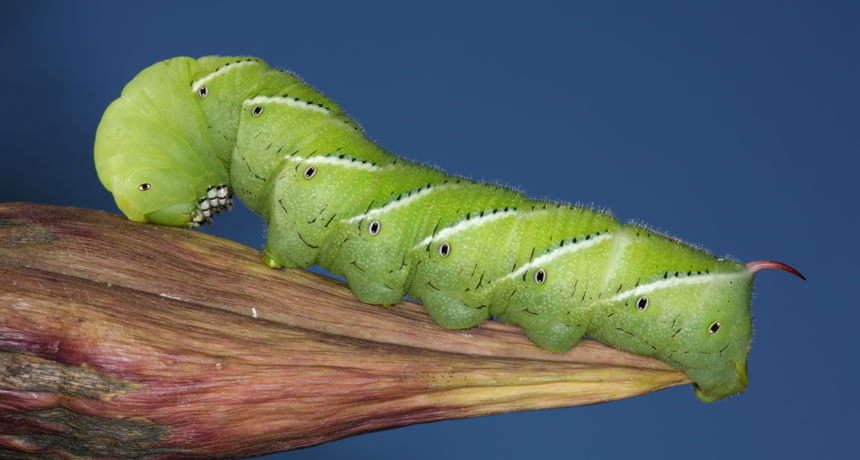The bad-breath defense
Caterpillars that munch tobacco fend off predatory spiders by exhaling nicotine

Tobacco hornworm caterpillars eat tobacco plants, which contain nicotine. Scientists identified a gene that helps the caterpillars move nicotine in their gut to their breath. The insects’ breath is bad enough to repel wolf spiders that normally would eat them.
Daniel Schwen / Wikimedia Commons
Bad breath can save a life. For caterpillars, anyway.
Tobacco hornworm caterpillars are plump, striped insects that feast on a type of wild tobacco plant. That meal provides more than nutrients. It also makes the insects’ breath so stinky that some predators flee.
“I think it’s actually the first example of using bad breath as a defense,” Ian Baldwin told Science News. But, he added, “I’m sure that everybody has had a personal encounter of something similar.”
Baldwin is a chemical ecologist. That’s a scientist who studies how living things use chemicals to survive in their environment. He is based at the Max Planck Institute for Chemical Ecology in Jena, Germany. His team reported on the caterpillars’ stinky defense December 30 in the Proceedings of the National Academy of Sciences.
Many types of tobacco plants contain the chemical nicotine. This is the highly addictive ingredient in cigarettes that gives smokers a buzz of pleasure. It’s also a natural poison that helps plants fight pests. At one time many farmers even used it as a pesticide. But the nicotine levels in tobacco plants don’t kill the hornworms. In fact, the insects harness it as a chemical bodyguard.
Baldwin’s team found the bad-breath defense by comparing insects raised on normal tobacco plants with others that had dined on tobacco plants genetically modified to produce no nicotine.
Every living organism contains genes. Tucked inside almost every cell, genes carry the information that instructs each cell on what it should do. Some genes in tobacco tell it how and when to make nicotine. Baldwin and his coworkers changed these genes in some plants so that they no longer make nicotine.
When a hornworm caterpillar ate normal tobacco leaves, the insect’s breath — which comes out of tiny structures called spiracles — turned nasty, the scientists found.
That halitosis (another word for bad breath) was strong enough to drive away wolf spiders. These predators normally would feast on hornworms. But now the spiders “just touch them — uff! — and jump away,” Baldwin told Science News.
At an outdoor site in Utah, the scientists placed the genetically modified plants alongside others that make nicotine. Caterpillars that fed on the ordinary plants were more likely to stay alive at night. But those dining on nicotine-free leaves disappeared in larger numbers. Wolf spiders were eating them up, the researchers discovered.
The scientists wanted to know how the caterpillars turned nicotine into a defense for themselves. They identified a gene that helped caterpillars move nicotine out of their gut so it could be puffed out in their breath.
In the lab, the biologists placed wolf spiders and hornworms together in a dish. The spiders attacked. But they quickly fled if the caterpillars had been eating ordinary tobacco leaves. Not so for caterpillars that had been eating tobacco genetically modified to block the insect’s use of nicotine as a self-defense. Those caterpillars became the spiders’ lunch.
Ecologists have been studying hornworm caterpillars for a long time. In fact, the insect should be “depressingly familiar” by now, May Berenbaum told Science News. She is an entomologist, or insect scientist, at the University of Illinois at Urbana-Champaign. She points out that Baldwin and his coworkers were able to learn something new because they started by studying caterpillars in the wild.
The bad breath defense, she says, “would never have been uncovered in just the lab.”
Power Words
ecology A branch of biology that deals with the relations of organisms to one another and to their physical surroundings. A scientist who works in this field is called an ecologist.
entomology The scientific study of insects. One who does this is an entomologist.
gene A segment of DNA that codes, or holds instructions, for producing a protein. Offspring inherit genes from their parents. Genes influence how an organism looks and behaves.
halitosis Bad breath.
pesticide A chemical or mix of compounds used to kill insects, rodents or other organisms harmful to cultivated plants, pets or livestock, or unwanted organisms that infest homes, offices, farm buildings and other protected structures.
spiracle Pores on the body of an insect that allow for the exchange of gases.







